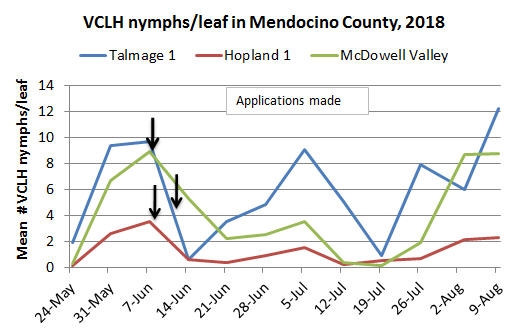- Author: Ryan F. Keiffer
- Editor: Lucia G. Varela
Monitoring efforts during the week of May 14th showed the first emergence of VCLH nymphs for the season (see Table 1/Figure 1 for # VCLH nymphs per leaf). The numbers of nymphs decreased on the week of June 11th as the three vineyards we are monitoring were sprayed for the first generation brood around that time. On August 9th we observed primarily small nymphs, 1st-3rd instars, but some nymphs ranged up to the final (5th) instar. If a treatment is warranted, target small nymphs. The nymph population will continue to increase due to VCLH generation overlap. We observed presence of viable VCLH eggs and nymphs across all sites being monitored. The leafhopper adults will begin moving higher up into the canopy to oviposit their eggs and thus we will be monitoring nodes 4-8.
Due to the lack of biological control, effective early-season control of VCLH is critical. Based on monitoring, if control measures are needed, the optimum application period would be when the majority of the population is still in the younger nymphal stages. Depending on population levels at your site, follow-up applications may be required depending on previous treatments and leafhopper population thresholds, so it is important to continue to monitor for nymphs. Now would be a good time to consult your PCAs for materials, rates and timing advice for follow-up applications for leafhoppers.
Table 1. Average number of Virginia creeper leafhopper nymphs per leaf at three locations in Mendocino County, 2018.
|
|
Average # of VCLH nymphs/leaf |
|
|
|
|
|
|
|
||||
|
Location |
May 24 |
May 31 |
June 7 |
June 14 |
June 21 |
June 28 |
July 5 |
July 12 |
July 19 |
July 26 |
August 3 |
August 9 |
|
Talmage 1 |
1.9 |
9.4 |
9.7 |
0.6 |
3.5 |
4.8 |
9.1 |
5.1 |
0.9 |
7.9 |
6 |
12.2 |
|
Hopland 1 |
0.1 |
2.6 |
3.5 |
0.6 |
0.4 |
0.9 |
1.5 |
0.2 |
0.5 |
0.7 |
2.1 |
2.3 |
|
McDowell Valley |
0.3 |
6.7 |
8.9 |
5.3 |
2.2 |
2.5 |
3.5 |
0.4 |
0.1 |
1.9 |
8.7 |
8.8 |
Figure 1. Average number of Virginia creeper leafhopper nymphs per leaf at three locations in Mendocino County, 2018.
Ryan Keiffer and Lucia Varela, UCCE, are conducting the 2018 leafhopper monitoring. For more information, please visit the Areawide Virginia Creeper Leafhopper website: http://ucanr.edu/sites/vclh/



